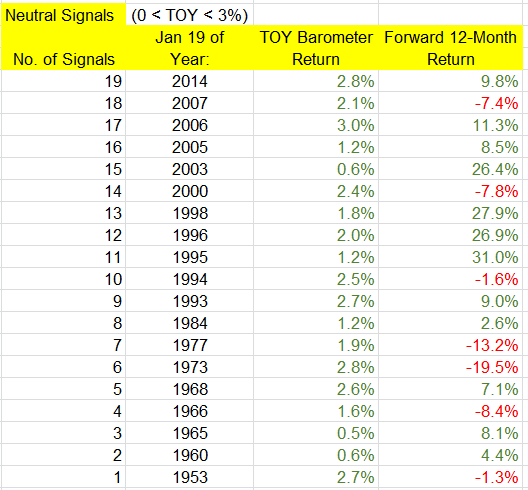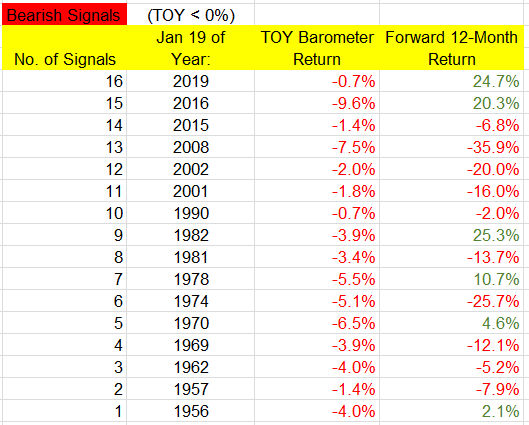Wayne Whaley was a quant before quants existed. He has a math background and has been managing money since the late 1980’s.
He considers the TOY Barometer to be the single most reliable seasonality barometer of forward stock market returns – so much so that he’s said if he could only make one trade/year based on one indicator, this is the indicator he’d use.
Whaley’s goal was to identify what he called the “kingpin of seasonal barometers.” He stated: “I implored my computer to take a few seconds to exhaustively study S&P performance over every time period of the year and determine which time frame’s behavior was proprietor of the highest correlation coefficient relative to the following year’s performance.”
What he found was there was a high correlation between the S&P 500’s returns between November 19th and the following January 19th and the S&P’s performance the 12 months following January 19. And since the 2-month period straddled the turn of the year (TOY) and the gift giving season, he called it the TOY Barometer.
Specifically, the period studied is November 20 – January 19 (if Nov 20 is on a weekend, use the Monday after the weekend, and if Jan 19 is on a weekend, use the Friday before). He only considered the price-only return (no dividends).
If the return during this 2-month period was greater than 3%, a bullish signal was given, and the market was very likely to do well over the following 12 months. If the return was 0-3%, the signal was considered neutral, and results were somewhat random and in line with what is considered average. And if the return was negative, a bearish signal was given, and returns tended to be very poor.
Since 1950, there have been 36 bullish signals (including the one that just triggered), 19 neutral signals and 16 bearish signals. Let’s look at each signal group.
Bullish Signals
The 35 completed bullish signals have led to gains 33 times the following 12 months. The losses were in 1987, the year of one of the biggest single-day crashes in history, and 2018, that year that included a 20% drop during the fourth quarter.
The average and median gains of the 12 months following the bullish signals were 17.7% and 15.1%. This isn’t much better than the “all years” stats, but the win rate (94%) is much higher than the “all years” win rate (73%).

Neutral Signals
There have been 19 neutral signals. The following year was positive 12 times (63%) and negative 7 times (37%). The overall average and median returns were 6.0% and 7.1%. But among the “up” years, the average and median gains were 14.4% and 9.4%, while the “down” years’ average and median losses were -8.5% and -7.8%. There were several big up years (1995, 1996, 1998, 2003), and two big down years (1973, 1977), so even if there is a neutral signal, there’s still a decent chance the following 12 months will venture far from its January 19 print.

Bearish Signals
There have been 16 bearish signals. Only 6 (38%) of the following years posted a gain while 10 posted losses – and 6 of those 10 posted double digit losses. The overall average and median returns were -3.6% and -6.0%. The “up” years posted average and median gains of 14.6% and 15.5%, while the “down” years posted average and median losses of -14.6% and -12.9%. So despite the low win rate, when the market does well, it has the ability to do very well, as was the case this past year.

Here’s a summary.
The bullish years have a very high win rate (94% vs 73% for “all years”). The average gain (17.7%) isn’t much higher than the “all years” gain (16.6%), so a bullish signal increases the odds of an up year but doesn’t increase the gain itself.
The bearish years have a low win rate (38%). The gains during those up years (14.6% vs 16.6% for all years) are very good, but the losses during the down years are noticeably bigger than when a bullish or neutral signal is signaled (-14.6% vs -6.2% for bullish years and vs -8.5% for neutral years). So the odds of a down year are much higher, and the losses that follow are much bigger.
The neutral years are mixed. The win rate is 63% (vs 72% for “all years”), with the gains during up years being pretty good (14.2% vs 16.6% for “all years”) and the losses during down years being moderate (a little worse than bullish years but much better than bearish years).
In summary, most notable – and yes this table is a little confusing – is the following: When a bullish signal is in play, odds heavily favor solid gains over the following 12 months, but when there’s a bearish signal, odds favor a down year with a relatively big loss. But regardless of the signal, “up” years tend to be very good.

The most recent TOY period just concluded. The current signal is bullish (see the top line of the “bullish” table above).
Odds favor the next 12 months posting a solid gain.
Jason Leavitt
Jason@leavittbrothers.com
2 thoughts on “Wayne Whaley's TOY Barometer”
Leave a Reply
You must be logged in to post a comment.
comforting, fantastic!
Nice for long term investors.